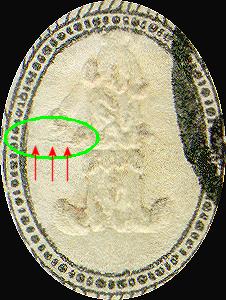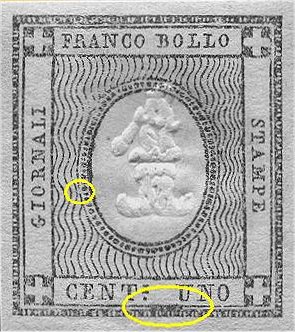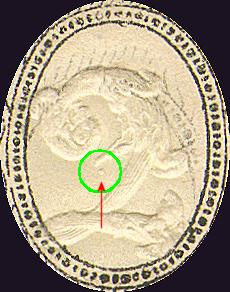|
1 centesimo
|
Black
|
| 2 centesimi |
Black
|
In origin these two
values were supposed to be used only on printed material and on newspapers
but they were used for the mail too.
The subject, as always made by Matraire, measures 18x20mm. Presents in the
center the value "1" or "2" in relief, with a character
quite elaborated and flourish (by purpose of difficult cloning), enclosed
in a double oval frame fulfilled with small dots. All around there is a rectangle
of dense waiving vertical lines, more dense to the right (detail desired for
security?). Around, enclosed in a double rectangular frame the label (from
left) "GIORNALI", "FRANCO BOLLO", "STAMPE",
"CENT.I 1" (or "2"). In the four corners
there are little white crosses on black.
The printing was done in sheets of 100 pieces, divided in two groups of 50
parts placed side by side and separated by an inter-space of about 2.5 millimeters.
The printing, typographic, is on machine made paper of variable thickness
and thicker for the very first printing runs.
For the printing of the values in relief, the same two methods utilized for
the IV issue were used: both the one with 50 pieces matrix tool as well as
the one with a couple of them. In this case too the utilization of the couple
method ruined one of the 1 centesimo tools that sometimes presents a minimal
break on the left (Fig. 1).

Fig. 1: the small break of the 1 centesimosimo
In addition one of the couples used (the second one, for accuracy) presents the right value clearly tilted to right (Fig. 2).

Fig. 2: pair with right sample with the tilted value
Again on the 1 centesimo,
this value presents always two peculiar characteristics: a spot in the lower
white external frame and an interruption of the more external oval of the
center frame. Both these details, may be, have been by design inserted to
identify them against possible forgeries (Fig. 3); as we saw in fact
for other Sardinia issues, Matraire was not new to these tricks...

Fig. 3: the two constant defects of the 1 centesimo
As for the 2 centesimi tool, it should be noticed as it presents always a small white dot in the center, visible with a good amplification (Fig. 4); the samples without that characteristics are somehow rare and come from the use of a initial tool that got ruined in short time (be careful not to confuse them with pieces with not so evident relief).

Fig. 4: the dot in relief almost always visible in
the 2 centesimi
(This sample presents also a double printing of the frame)
Between the varieties more known we have double embossing, exchanged values, missing value, value in between two samples, values upside down, double printings. The color shade presents sometimes light variations through the gray, brown and greenish.
Due to the easy possibility that the two values could get confused, in April 1862 the 2 centesimi value was reissued in yellow ochre (then it was printed in Italy Kingdom period, but its "historic" location is very much debated).
The quantity issued is not known. They were valid up to December 31st 1863.